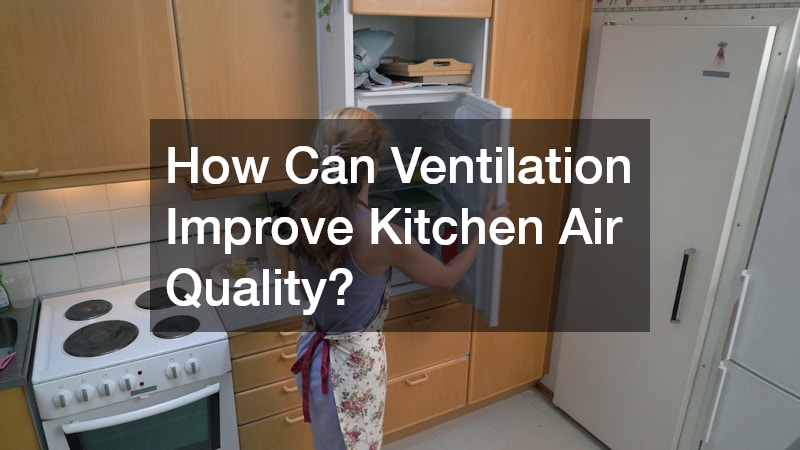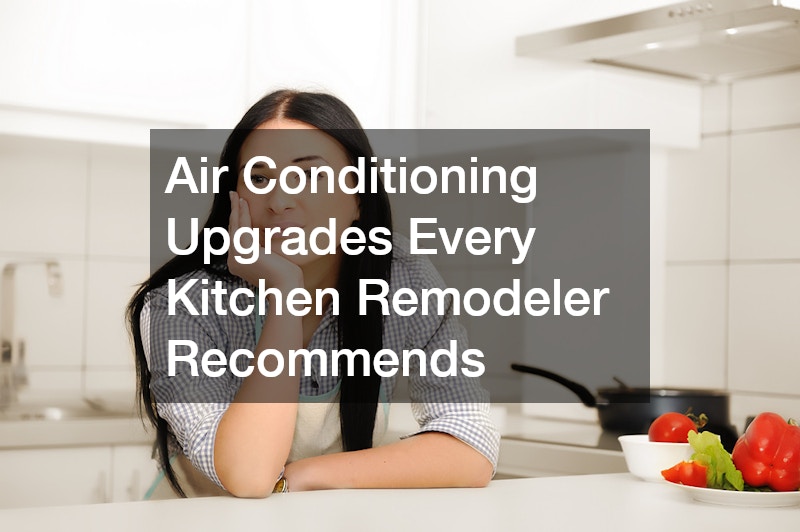Air conditioning repair isn’t something you consider during a kitchen remodel, but perhaps you should. Kitchen remodels are not just about aesthetics; they are also an opportunity to improve the comfort and functionality of one of the busiest areas of the home. Among the many upgrades homeowners consider during a remodel, air conditioning plays a crucial role in maintaining a comfortable environment while cooking, entertaining, or simply spending time in the kitchen. Proper air conditioning not only keeps temperatures stable but also helps control humidity, reduce odors, and improve indoor air quality.
Selecting the right system, whether it’s a new installation or an upgrade to an existing unit, requires careful thought. Kitchen remodelers often recommend considering factors such as energy efficiency, the layout of the space, and the integration of HVAC components with other household systems. From choosing the right ac companies for installation to understanding how HVAC service impacts long-term efficiency, there are many decisions that can significantly affect comfort and energy costs. This article explores these recommendations, guiding homeowners through air conditioning options, smart thermostat features, ventilation improvements, and maintenance tips to ensure a kitchen that stays cool, efficient, and enjoyable year-round.
What Are the Most Energy-Efficient Air Conditioning Options for Kitchens?

Understanding SEER Ratings
SEER, or Seasonal Energy Efficiency Ratio, is a critical measurement for evaluating the energy efficiency of air conditioning units. Higher SEER ratings indicate better performance and lower energy consumption. Homeowners considering air conditioning upgrades during a kitchen remodel should pay attention to this number because kitchens can generate a lot of heat from cooking appliances, making efficient cooling essential.
Energy-efficient units with high SEER ratings not only reduce monthly energy bills but also improve the overall lifespan of HVAC systems. When selecting ac installation services, it’s wise to consult with local ac companies to find units that balance performance with affordability. Regular HVAC service and proper maintenance further enhance efficiency, ensuring that the cooling system performs optimally even during peak cooking times. By understanding SEER ratings, homeowners can make informed choices that combine comfort, efficiency, and cost-effectiveness.
Comparing Central vs. Ductless Systems
Central air conditioning systems are common in many homes, offering even cooling across multiple rooms. However, ductless systems, also known as mini-splits, provide flexibility in targeted cooling areas, which can be particularly useful in kitchen spaces where heat tends to accumulate near cooking zones.
Central air conditioning may require extensive ductwork adjustments during a remodel, but it offers consistent airflow and is compatible with most HVAC service plans. On the other hand, ductless systems allow homeowners to install cooling units precisely where needed, often with less disruption and lower installation costs. Both options have benefits, and a consultation with a qualified ac repair company or ac installation professional can help determine which system aligns best with a kitchen’s layout, cooking habits, and long-term energy goals.
How Can Air Conditioning Improve Kitchen Comfort?
Maintaining Optimal Cooking Temperatures
Cooking generates significant heat, especially during baking or using multiple appliances simultaneously. Proper air conditioning repair helps maintain a comfortable temperature, preventing the kitchen from becoming uncomfortably warm. Remodelers often suggest placing units strategically to ensure airflow reaches areas prone to heat buildup.
In addition to overall comfort, maintaining optimal temperatures can improve cooking efficiency. Certain dishes require consistent ambient temperatures to prevent overheating or affecting delicate ingredients. AC repair companies can recommend systems that maintain stability in kitchen environments, while regular HVAC service ensures these units operate without interruptions. Pairing air conditioning with proper ventilation further enhances comfort, reducing reliance on temporary cooling solutions like fans or open windows.
Reducing Humidity Levels
High humidity can make kitchens feel sticky and exacerbate heat during cooking. Air conditioning systems naturally reduce moisture in the air, helping maintain a balanced humidity level. This also protects cabinets, flooring, and countertops from warping or damage caused by excess moisture.
By integrating AC installation with effective ductwork and humidity control, remodelers can create a kitchen environment that feels fresh and inviting. Local HVAC experts often provide guidance on cooling services that combine temperature control with dehumidification, ensuring the space remains comfortable and safe for food storage. Regular maintenance of air conditioning units is essential to keep humidity control consistent, as neglected systems can lose efficiency over time.
What Should Homeowners Consider Before Upgrading Air Conditioning?

Kitchen Layout and Airflow
The layout of a kitchen significantly affects how air conditioning performs. Open floor plans may allow for easier airflow, while kitchens with enclosed spaces or multiple partitions might require additional cooling solutions. Remodelers often recommend evaluating placement for AC units during the design phase to ensure even distribution of cool air.
Strategically placed vents and ducts, along with local HVAC filters, can enhance airflow and prevent hotspots. Consulting with ac companies during the remodel allows homeowners to align air conditioning placement with cooking zones, seating areas, and appliances that generate heat. Proper airflow planning minimizes the need for excessive energy consumption and improves the overall effectiveness of HVAC service throughout the home.
Budgeting for Upgrades
Air conditioning upgrades can vary widely in cost depending on the type of system, the size of the kitchen, and installation requirements. Homeowners should consider both upfront costs and long-term savings when budgeting for improvements.
Investing in energy-efficient units with higher SEER ratings may cost more initially but can reduce monthly energy bills. Ac repairs and regular HVAC maintenance should also be factored into long-term budgets to avoid unexpected expenses. By consulting ac repair companies or HVAC service providers, homeowners can gain a clear picture of costs, financing options, and potential rebates, allowing for smart investment decisions during a kitchen remodel.
How Do Smart Thermostats Enhance Kitchen Cooling?
Programmable Settings for Efficiency
Smart thermostats allow homeowners to program cooling schedules that align with daily routines, helping reduce energy consumption while maintaining comfort. During meal prep or gatherings, the system can automatically adjust to meet increased cooling demands.
Many ac companies now offer smart thermostat integration during ac installation. Using programmable settings, homeowners can optimize efficiency without constantly adjusting controls manually. Combined with routine HVAC service, these devices ensure that air conditioning units maintain consistent performance, respond to usage patterns, and reduce energy costs over time.
Remote Control and Monitoring
Remote access features in modern thermostats enable homeowners to monitor and adjust air conditioning systems from anywhere. This is particularly useful for maintaining kitchen comfort while cooking or entertaining, even if the homeowner is in another part of the house.
With mobile apps and cloud-based monitoring, HVAC service professionals can provide support and troubleshooting remotely, and ac repair companies can quickly identify issues before they escalate. Remote control ensures that air conditioning remains efficient, responsive, and adaptable to real-time needs, enhancing overall comfort in renovated kitchens.
What Role Does Insulation Play in Cooling Efficiency?

Importance of Proper Insulation
Insulation acts as a barrier to heat transfer, helping air conditioning systems maintain stable indoor temperatures. Proper insulation in walls, ceilings, and floors minimizes energy loss, reduces cooling costs, and allows HVAC units to operate more efficiently.
During kitchen remodels, homeowners often overlook insulation, focusing on aesthetics rather than energy performance. However, remodelers emphasize that well-insulated kitchens complement air conditioning upgrades by preventing hot air from entering and cool air from escaping. Regular HVAC service and attention to local HVAC filters further enhance the effectiveness of cooling systems by ensuring clean airflow and reducing strain on AC units.
Upgrading Insulation During a Remodel
Kitchen renovations provide an excellent opportunity to upgrade insulation. This can involve adding layers to existing walls, installing energy-efficient windows, or improving attic insulation. Upgraded insulation works hand in hand with air conditioning systems, maximizing efficiency and comfort.
AC companies can advise on insulation types that work best with specific cooling systems, whether central air or ductless mini-splits. Investing in proper insulation now can prevent costly HVAC repair and reduce long-term energy bills, ensuring that the kitchen remains comfortable for years to come.
Are There Specific Air Conditioning Units Recommended for Small Kitchens?
Compact and Efficient Models
Small kitchens often require targeted cooling solutions that do not overwhelm the space or consume unnecessary energy. Compact air conditioning units, including ductless mini-splits and wall-mounted systems, are ideal for these scenarios. They provide efficient cooling without extensive ductwork, making them suitable for smaller layouts.
When selecting a compact unit, it’s important to consult ac companies experienced in kitchen remodels. Proper sizing ensures that the unit provides sufficient cooling without frequent cycling, which can strain the system and increase the likelihood of ac repairs. Additionally, incorporating local HVAC filters ensures clean airflow, reduces dust buildup, and maintains overall air quality in the kitchen, making the space both comfortable and healthy.
Benefits of Portable Air Conditioners
Portable air conditioners are another practical option for smaller kitchens or temporary cooling needs during renovations. They can be moved as needed and require minimal installation, making them an attractive choice for homeowners seeking flexibility.
While portable units may not match the efficiency of permanent systems, they offer convenience and immediate relief from heat. Regular HVAC service and filter maintenance are still essential to keep portable units functioning optimally. Ac repair companies can provide guidance on when portable solutions are appropriate and how to maintain them for the best performance.
How Can Ventilation Improve Kitchen Air Quality?

Integrating Ventilation with AC Systems
Proper ventilation complements air conditioning by removing excess heat, smoke, and cooking odors from the kitchen. Ventilation systems, such as range hoods or ducted exhausts, work alongside HVAC units to maintain balanced temperatures and improve indoor air quality.
During a kitchen remodel, integrating ventilation with air conditioning systems ensures that both work efficiently. AC installation professionals and HVAC service providers can design layouts that optimize airflow, prevent hot spots, and maintain consistent cooling. This integration also reduces the frequency of ac repairs by alleviating strain on the system caused by trapped heat and humidity.
The Importance of Exhaust Fans
Exhaust fans play a critical role in maintaining kitchen comfort, particularly when air conditioning is in use. They remove airborne grease, smoke, and moisture, preventing buildup that can interfere with cooling efficiency.
Local ac companies often recommend pairing air conditioning systems with high-quality exhaust fans to maximize performance. Properly maintained fans, combined with routine HVAC service, contribute to a cleaner, more comfortable cooking environment and help extend the lifespan of air conditioning units. Incorporating these elements during a remodel ensures a seamless blend of comfort, efficiency, and air quality.
What Maintenance Is Needed for Air Conditioning Units?
Regular Maintenance Tasks
Routine maintenance is essential for keeping air conditioning systems operating efficiently, particularly in high-use areas like kitchens. Common tasks include cleaning or replacing local HVAC filters, inspecting ductwork, checking refrigerant levels, and ensuring the system is free from debris.
Homeowners who schedule regular HVAC service with trusted ac companies can prevent costly repairs and improve system longevity. Maintenance also helps sustain energy efficiency, ensuring that air conditioning units consistently deliver the cooling needed for comfortable kitchen environments. By following recommended schedules, homeowners can avoid sudden malfunctions and minimize the need for emergency ac repairs.
Signs Your AC Needs Repair
Recognizing early signs that an air conditioning unit requires attention can prevent more significant issues and costly downtime. Common indicators include uneven cooling, unusual noises, increased energy bills, or reduced airflow.
When these signs appear, contacting a qualified ac repair company promptly is crucial. Regular HVAC service can identify and address minor problems before they escalate, ensuring reliable performance. Local ac companies can also advise on whether repairs or replacements are most cost-effective, helping homeowners maintain a consistent, comfortable temperature in the kitchen and throughout the home.
Air conditioning upgrades are a vital component of modern kitchen remodels, directly influencing comfort, energy efficiency, and overall usability of the space. By carefully considering factors such as energy-efficient options, smart thermostat integration, ventilation improvements, and maintenance routines, homeowners can create kitchens that remain comfortable even during heavy cooking sessions or hot summer months.
Collaboration with experienced ac companies ensures that installations and repairs are handled professionally, while attention to local HVAC filters and system upkeep prolongs the life of air conditioning units. From compact solutions for smaller kitchens to central systems for larger layouts, proper planning and installation can significantly reduce energy costs while maintaining consistent airflow and temperature control. Remodelers who prioritize these upgrades not only enhance daily comfort but also protect long-term investments in kitchen design, cabinetry, countertops, and overall home value. By embracing these recommendations, homeowners can enjoy a kitchen that is both stylish and perfectly cooled, making cooking and entertaining more enjoyable year-round.

